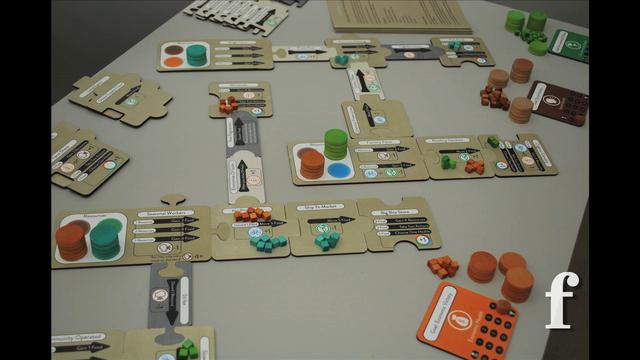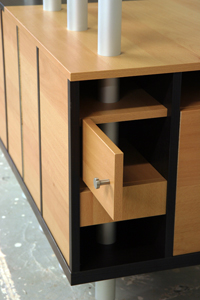AA: Can you talk about that, and the decision to develop the student center? I’m curious about your part in its planning, what it will be, and why it’s taken nearly 150 years to come about.
TJ: Well, that’s a good point. We’ve been talking about the student center for years. One of the questions is where? And that goes back to the cold weather. If you put it in one building, people in the other buildings are going to say, “Well, we’re never going to go there in the winter because it’s too freezing cold to cross the street,” that’s why we have these little duplications of things. You can’t leave the winter out of your planning. But we always wanted to have one place that was as centrally located as possible, so that it was accessible. Where students could meet, etc, talk, see work on the walls, a social space, a gallery space, a mixing space. It was a priority of mine. Coming to the end of my time here, as chancellor, I thought that this would be a very good time to work on this.
I’ve developed over the years a very good relationship with our alum Leroy Neiman, and his wife Janet Neiman, who was also a student here, they met here. I talked to Janet and Leroy about a scholarship program, so Leroy created the master classes and that became a scholarship program, so Leroy made a gift of $3 million for that. Then we came upon the 100th anniversary of Oxbow, and Leroy taught at Oxbow, so he was not only a student to the School but a member of the faculty for 12 years here, an extremely popular teacher. I asked Leroy if he could help with the scholarship of Oxbow, so that students could spend the summer there, and he very generously gave me a $1 million gift. But as I came to what I decided to be the end of my time here, I went back to Leroy and said that the real priority that we have in the School is to do something for students where they have a chance to mix and mingle. So I talked to people like Claes Oldenburg and Leroy and people who were alumni, and each of them said one of the most important things about the School was the social space — and Leroy came back and said that was important to him, too, and so he made an extremely generous gift of $5 million, which has allowed us to build the student center. We have an architect, we have a plan — so finally, that has been done.

AA: You’ve had so many experiences in your tenure at SAIC — from “Mirth and Girth”target=”_blank” and Dred Scott Tylertarget=”_blank”, and all of these things that are really iconic within the history of the School — what are some of your most memorable moments?
TJ: Well, those are memorable, but they’re unpleasant. It was dangerous, it was physically dangerous. Students were being assaulted by members of the public on the El. I don’t have a car, so I was being picked up and brought to the school by a police car. People discovered my telephone number so I got death threats — they were serious death threats, these people weren’t kidding. There was a series of arrests, people who were armed, who had knives. It was a very dangerous and very turbulent time. No one wants to go through that, but it ended up, if you look at the cultural context, Amanda, you can’t leave out the Robert Mapplethorpe things that were going on at the same time. Congress was hysterically angry over the exhibition of works that had been funded by the National Endowment. There was rampant homophobia because of the Mapplethorpe things.
I am a veteran of the American art wars, but it isn’t anything that I think of as being a lot of fun. We were very concerned for the safety of students, we had to pull people off the switchboards, and the faculty stood up and volunteered to take over the switchboards, because the level of abuse and filth that came forth was incomprehensible. It was extremely violent and disgusting. So people’s emotions were very inflamed, and we had to protect the people in the building, but we also had to protect our academic mission. We were dragged into court, it was a first amendment issue, we closed the exhibition, reorganized all the security, reopened and went on for another 28 days. The veterans organized and surrounded the building, “Hey, hey, ho, ho, get the flag up off the flo,” ran, ran, ran the building, throwing things at the building, people threatening to come in and tear the paintings off the walls. Not the student paintings, but the paintings in the museum. It was a very very highly charged political situation in the city, too. There was a lot of stuff going on in the city that was very bad. So I’m not sure I would describe that as a high point or a low point, but it was a point. Ironically, while “flag on the floor” was going on, the Mapplethorpe exhibition was at the MCA] without protest. The lightening had struck us, it didn’t go up Michigan Ave.
AA: What do you view as your greatest accomplishment throughout your tenure at SAIC?
TJ: I think it’s the steady state of growing the school. If you leave out the controversial things that cause lots of problems, the school has just grown and matured from being a very well respected city school, to becoming a great regional school, becoming a nationally recognized school, internationally recognized school, and now there’s set to be 12 great art and design schools in the world, and the three in the US are Yale, SAIC and RISD. I wanted this school to have that reputation, so that students could come here and know that they’re not only receiving a set of really terrific opportunities to take their ideas in any direction they want to, but doing it in a school that has international recognition. The multiculturality, the fact that there are so many students from so many different cultures, I think is critically important. It’s the mark of a great school that you have that range of expression, and finally, we have studios and workshops that are appropriate.
It’s thinking back, from my perspective, thinking back to arriving here, looking at the Columbus Drive building and thinking, “Oh my god. How can working artists and designers be in here? This just simply is not good enough. We’ll never be the school that gives a first class education to its students if its like this. This isn’t good enough.” So I developed a ten year plan to grow the school in terms of its scale, its opportunities for students, its range of international programs. If you look at the School’s track record, particularly during the Deanship of Carol Beckertarget=”_blank”, we introduced a new academic program every 18 months for years and years and years. The idea was that you respond to student need. I see it as a deepening of the student experience, allowing them to move within this pool of resources in a different way.
In the coming weeks, www.fnewsmagazine.com will feature a series of videos from this interview on the homepage.








[…] if you don’t like my art, the website is […]